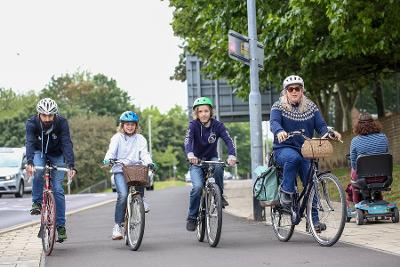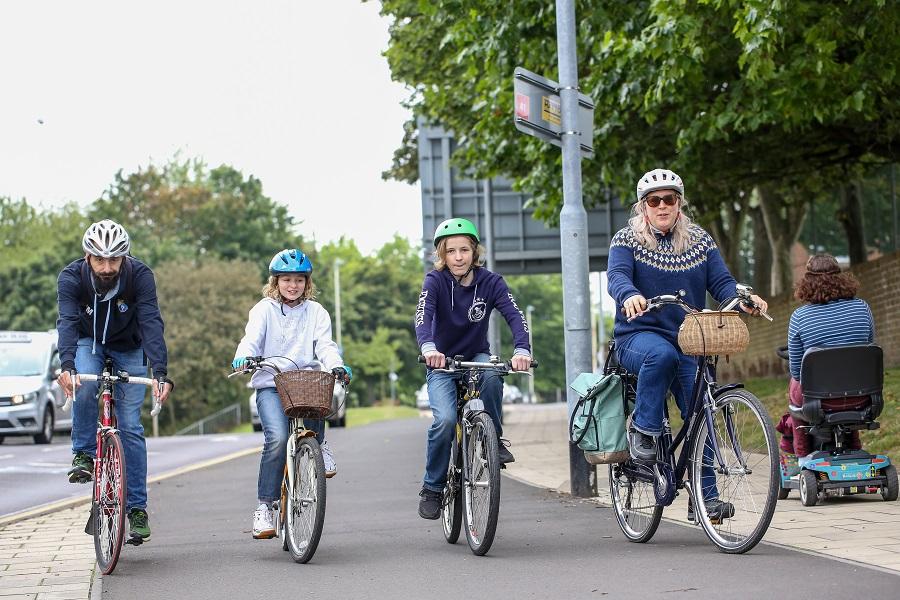Report shows walking and wheeling are main forms of urban transport, but there are inequalities

A major new study of walking, wheeling and cycling in Tyneside has shown that people walk or wheel more frequently than any other form of urban transport, but not everyone has equal access to active travel.
The Walking and Cycling Index for Tyneside is published by Sustrans in partnership with Gateshead Council, Newcastle City Council, and North Tyneside Council. It includes an independent survey of 1,264 residents aged 16 or above, as well as updates on local walking and cycling infrastructure.
Results show that 49% of people walk and wheel, and 5% cycle at least five or more days each week, compared to 36% of people who drive and 11% who use public transport.
Wheeling refers to the use of wheelchairs (manual and electric) and mobility scooters, to include those using the same environment but who may not identify with walking.
The report reveals that access to walking, wheeling and cycling is not universal. While 51% of white people walk at least five days a week, only 29% of people from ethnic minorities opt to walk that frequently. Men are more than twice (22%) as likely as women (10%) to cycle at least once a week.
While 68% of people feel welcome and comfortable walking, wheeling or spending time on the streets of their neighbourhood, only 57% of people think the level of safety for children walking is good and 35% for children cycling.
Proximity of local services and amenities also prevents people walking and wheeling, as only just over half of respondents (56%) agreed they could easily get to many places they need to visit without having to drive. 79% of residents want to see more everyday shops and services close to where they live and 84% want to see more parks and green spaces, as that would help them to walk or wheel more.
The report also shows clear support for measures that help more people walk, wheel and cycle for their regular journeys. Banning pavement parking would help 68% of residents to walk or wheel more, and 65% of residents support low traffic neighbourhoods. Nearly three quarters of respondents say wider pavements (71%) and better accessibility (71%) would encourage them to walk or wheel more.
While only 5% of people cycle five days a week there is huge potential for cycling as a form of transport if conditions were safer and easier for everyone. Nearly a quarter (23%) of residents say they don't currently cycle but would like to. The potential is even higher for some groups, including people from ethnic minorities (33%), women (27%) and disabled people (25%).
Only 44% of people think cycle safety is good in their local area. Just 15% of households are within 125m of a cycle route typically considered to be safer, such as protected cycle tracks or traffic-free cycle routes.
The Tyneside Walking and Cycling Index, formerly known as Bike Life, is one of 18 reports released today by Sustrans. Surveys were carried out during summer 2021 following the lifting of Covid travel restrictions.
Rosslyn Colderley, Director of Sustrans for the North of England, said:
"The evidence is clear - walking and wheeling are the most popular forms of urban transport in Tyneside, but many more groups of people could benefit if conditions were improved. Walking and wheeling have significant benefits for our health and economy and there is huge untapped potential to help more residents choose these healthier, more environmentally-friendly forms of transport.
"Residents overwhelmingly support measures to help more people walk, wheel or cycle their journeys. They welcome developments in active travel throughout the region and are keen to invest more public funds to make it more widely accessible for everyone.
"The report shows us that people want to see safer streets with less traffic. They don't want outdated and unmaintained pavements, crossing points that make walking and wheeling unsafe or inaccessible, and vehicles parked on pavements getting in their way."
Martin Gannon, Chair of the North East Joint Transport Committee said: "This important report shows us where we are now, as well as identifying the barriers that still exist.
"We want to live in a region where active travel forms more of our everyday journeys. The results from this report give us additional evidence to put our plans into practice.
"The report also shows us that more needs to be done - 27% of women said they do not cycle but would like to; whilst 51% of white people walk at least five days a week compared to 29% of people from ethnic minority groups. We need to ensure representation in travel choices is as inclusive as possible."
Councillor John McElroy, cabinet member for the environment and transport at Gateshead Council, said: "It's encouraging that we're seeing so many journeys now completed on foot or by bike, but we know we have more to do to enable all sections of society to benefit from the advantages of active travel.
"We have recently employed a dedicated officer to look after Gateshead's cycle paths, and we will keep investing in improving the borough, and reducing the dominance of motor vehicles, so walking, wheeling and cycling are available to everyone."
More than 24,000 people were surveyed by Sustrans from 18 cities and areas across England, Scotland, Wales, Northern Ireland and the Republic of Ireland - representative of a total population of over 13 million people - as part of the biennial Walking and Cycling Index, formerly known as Bike Life.

A major new study of walking, wheeling and cycling in Tyneside has shown that people walk or wheel more frequently than any other form of urban transport, but not everyone has equal access to active travel.
The Walking and Cycling Index for Tyneside is published by Sustrans in partnership with Gateshead Council, Newcastle City Council, and North Tyneside Council. It includes an independent survey of 1,264 residents aged 16 or above, as well as updates on local walking and cycling infrastructure.
Results show that 49% of people walk and wheel, and 5% cycle at least five or more days each week, compared to 36% of people who drive and 11% who use public transport.
Wheeling refers to the use of wheelchairs (manual and electric) and mobility scooters, to include those using the same environment but who may not identify with walking.
The report reveals that access to walking, wheeling and cycling is not universal. While 51% of white people walk at least five days a week, only 29% of people from ethnic minorities opt to walk that frequently. Men are more than twice (22%) as likely as women (10%) to cycle at least once a week.
While 68% of people feel welcome and comfortable walking, wheeling or spending time on the streets of their neighbourhood, only 57% of people think the level of safety for children walking is good and 35% for children cycling.
Proximity of local services and amenities also prevents people walking and wheeling, as only just over half of respondents (56%) agreed they could easily get to many places they need to visit without having to drive. 79% of residents want to see more everyday shops and services close to where they live and 84% want to see more parks and green spaces, as that would help them to walk or wheel more.
The report also shows clear support for measures that help more people walk, wheel and cycle for their regular journeys. Banning pavement parking would help 68% of residents to walk or wheel more, and 65% of residents support low traffic neighbourhoods. Nearly three quarters of respondents say wider pavements (71%) and better accessibility (71%) would encourage them to walk or wheel more.
While only 5% of people cycle five days a week there is huge potential for cycling as a form of transport if conditions were safer and easier for everyone. Nearly a quarter (23%) of residents say they don't currently cycle but would like to. The potential is even higher for some groups, including people from ethnic minorities (33%), women (27%) and disabled people (25%).
Only 44% of people think cycle safety is good in their local area. Just 15% of households are within 125m of a cycle route typically considered to be safer, such as protected cycle tracks or traffic-free cycle routes.
The Tyneside Walking and Cycling Index, formerly known as Bike Life, is one of 18 reports released today by Sustrans. Surveys were carried out during summer 2021 following the lifting of Covid travel restrictions.
Rosslyn Colderley, Director of Sustrans for the North of England, said:
"The evidence is clear - walking and wheeling are the most popular forms of urban transport in Tyneside, but many more groups of people could benefit if conditions were improved. Walking and wheeling have significant benefits for our health and economy and there is huge untapped potential to help more residents choose these healthier, more environmentally-friendly forms of transport.
"Residents overwhelmingly support measures to help more people walk, wheel or cycle their journeys. They welcome developments in active travel throughout the region and are keen to invest more public funds to make it more widely accessible for everyone.
"The report shows us that people want to see safer streets with less traffic. They don't want outdated and unmaintained pavements, crossing points that make walking and wheeling unsafe or inaccessible, and vehicles parked on pavements getting in their way."
Martin Gannon, Chair of the North East Joint Transport Committee said: "This important report shows us where we are now, as well as identifying the barriers that still exist.
"We want to live in a region where active travel forms more of our everyday journeys. The results from this report give us additional evidence to put our plans into practice.
"The report also shows us that more needs to be done - 27% of women said they do not cycle but would like to; whilst 51% of white people walk at least five days a week compared to 29% of people from ethnic minority groups. We need to ensure representation in travel choices is as inclusive as possible."
Councillor John McElroy, cabinet member for the environment and transport at Gateshead Council, said: "It's encouraging that we're seeing so many journeys now completed on foot or by bike, but we know we have more to do to enable all sections of society to benefit from the advantages of active travel.
"We have recently employed a dedicated officer to look after Gateshead's cycle paths, and we will keep investing in improving the borough, and reducing the dominance of motor vehicles, so walking, wheeling and cycling are available to everyone."
More than 24,000 people were surveyed by Sustrans from 18 cities and areas across England, Scotland, Wales, Northern Ireland and the Republic of Ireland - representative of a total population of over 13 million people - as part of the biennial Walking and Cycling Index, formerly known as Bike Life.
